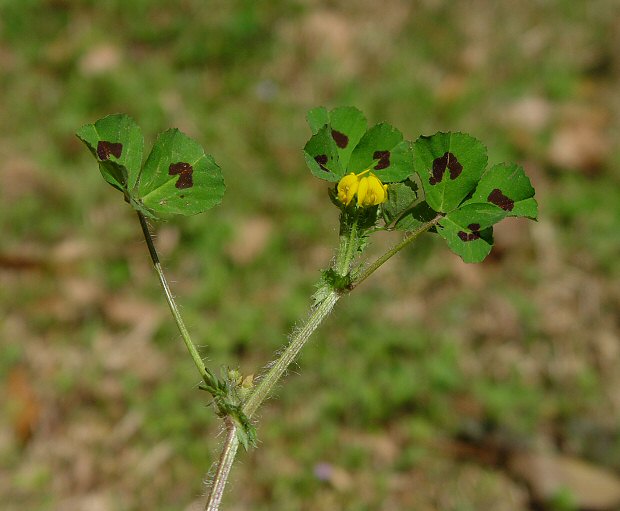Medicago arabica: Red Data Book of Armenia

VU* B 1 ab(iii) + 2 ab(iii)
Category. Vulnerable species. Only one sub–population is known. The extent of occurrence and the area of occupancy are less than 500 km2. The category of threat has been downgraded to VU because of the wide range of general distribution of the species. It was not included in the first edition of the Red Data Book of Armenia. It is not included in the Annexes of CITES and that of the Bern Convention.
Description. Annual, almost glabrous plants. Stems thin, slender, 20–60 cm. Stipules deeply dentate. Leaflets cordiform, often on the upper side in centre with brownish–red spot. Peduncle shorter than bract. Inflorescence 1–4–flowered. Corolla yellow. Legumes globular–cylindrical, 5–7 mm in diameter, with 3–7 coils, covered with small soft prickles.
Distribution. In Armenia it occurs in Zangezur ("Shikahogh" State Reserve, surroundings of Vahanavank) floristic region. AOO is 12 km2, the number of locations is 2. Besides Armenia the species grows in West Ciscaucasia, Dagestan, East and West Transcaucasia, Talish, almost the whole Europe, South–West Asia, North Africa.
Ecological, biological and phytocoenological peculiarities. Grows in lower mountain belt, at the altitudes of 700–1100 meters above sea level, in wetlands, meadows, in the glades, at the forest edges, in steppe shrubs. Flowering from April to May, fruiting from May to July.
Limiting factors. Restricted extent of occurrence and area of occupancy, small density of the population, restricted ecological suitability.
Conservation actions. Part of the population grows in "Shikahogh" State Reserve. Necessary: monitoring of the population state.
Suggestions
 The Ministry of Environment sent a letter international partners to draw their attention to the real danger of environmental disasters as a result of Azerbaijan's large-scale aggression towards the territory of Armenia
The Ministry of Environment sent a letter international partners to draw their attention to the real danger of environmental disasters as a result of Azerbaijan's large-scale aggression towards the territory of Armenia
 Vicia pisiformis: Red Data Book of Armenia
Vicia pisiformis: Red Data Book of Armenia
 Vavilovia formosa: Red Data Book of Armenia
Vavilovia formosa: Red Data Book of Armenia
 Trigonella capitata: Red Data Book of Armenia
Trigonella capitata: Red Data Book of Armenia
 Trigonella astroides: Red Data Book of Armenia
Trigonella astroides: Red Data Book of Armenia












